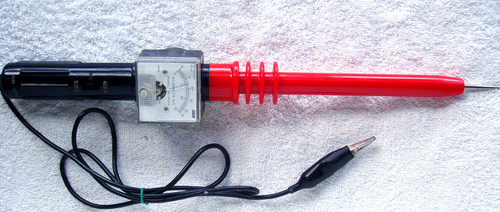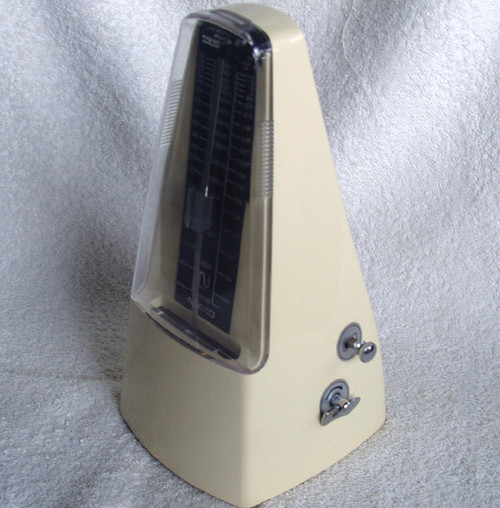Very nice for it's day, I wouldn't image anyone using one these days though
Great example of Japanese electronic test equipment from the early 1970's - Kaise has been operating since 1955 and still is to my knowledge.
Kaise Volt Ohm Milliammeter (Multimeter)
Model SK-100
100k Ohm per volt DC (very good at the time of release)
Very large meter scale
Mirrored to reduce parallax reading errors
Jewel meter movement
Basic specifications:
DC Volts: 0.3 to 1200V
AC Volts: 6 to 1200V
DC Current: 12uA to 12A
AC Current: 12A
Resistance: 2K Ohm to 20M Ohm
Decibels: -20 to +17dB
Accuracy FSD: 3% DC 4% AC
Uses 2x C size batteries (I have removed these to prevent battery leakage while being stored)
COSMETIC CONDITION:
I am not 100% on this but I suspect the black casing is bakelite material, it doesn't quite look right for plastic. The rear has JAPAN moulded into the case and the front panel labelling is actually etched into the case material and then white filler has been applied.
The tilt handle is metal with a thick vinyl covering.
NO cracks or bits like corners broken off - pristine condition
NO damage to the front panel labelling
NO damage or marks to the meter front
NOTE: I am supplying exactly as in the photographs, so you will get the multimeter, the original instruction manual (English but printed in Japan), the original box styro and the outer cardboard cover.
I WILL NOT supply the test leads - they have long disappeared somewhere here, it takes standard banana plug style connectors.
TESTING:
First up, I gave it a good clean INSIDE - especially the 3 position rotary switch, the zero adjustment pot and the main multi-position switch - the switches especially need to be cleaned each time you change the batteries (iso alcohol switch cleaning spray, rubbed with a cotton bud) as if these contacts are dirty, strange readings occur!
The meter movement is extremely sensitive at just 9uA FSD.
I just checked the resistance measurement, voltage and current - everything is fine, in fact it works surprisingly well after all these years!
Just one thing of note, but it is NOT a problem at the moment. Sometime in the past someone has passed excessive current through the meter and one of the metal film resistors has started to cook BUT it is not destroyed and checking the value against the circuit diagram (this is on the back of the manual) shows the resistance still to be spot on - see the photograph to view what I am talking about.
These units have no fuse inline with the meter, so if you pass too much current through, the worse that will happen is the pointer will get bent! and you may cook some of the resistors - so select your current ranges carefully.
Other than that, an excellent piece of Japanese test gear - not quite an AVO but nice none the less.
















